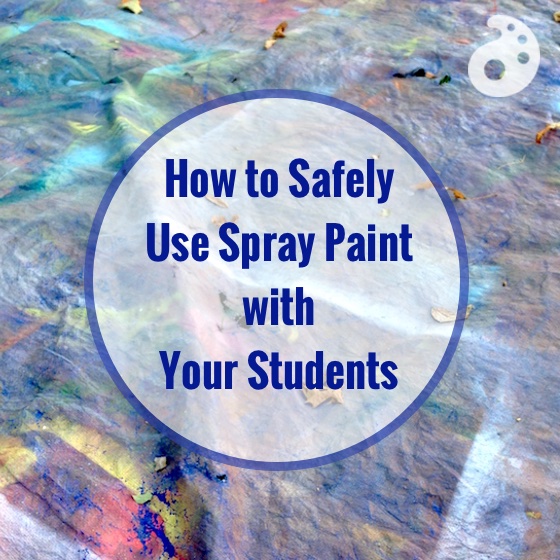
We all have tried-and-true projects in our arsenals that students love. These are the complete home runs. They are usually a great mix of technique, process, and choice. Regardless of students’ skill sets, all have a great deal of success.
Recently, I’ve stumbled across a new media that is
always a hit with my students–spray paint.
Students love spray paint for a variety of reasons: it coats thoroughly, dries almost immediately, and is capable of creating some pretty cool effects. All of these reasons are in addition to the obvious–it’s just plain fun.
When spray painting, it’s imperative to cover some important ground rules up front. Students need to know how to stay safe, how to effectively use the paint, and how to manage this (very permanent) medium.
Student Health and Safety
Spray paint fumes are a real concern, as student safety is of the utmost importance. You can’t just spray in your art room without proper ventilation. Honestly, spray booths can give both students and teachers a false sense of security. If the filters aren’t clean or the vents aren’t powerful enough, your spray booth is bad news! I wish I had a safe spray booth in my classroom, but I don’t. Therefore, all spray painting at my school happens outside.
Luckily, I have a room with a door that leads directly to a small, grassy courtyard area where the natural air provides tons of ventilation. Without this setup, I probably wouldn’t be able to safely allow my students to use spray paint. Part of this is because, with the courtyard, I can let pieces dry adequately before bringing them inside. Students used to spray things outside and bring them in right away, stinking up the entire room. This was no good! Now, I have students leave their projects on a tarp up against the building or on an old beat up picnic table I have outside. I then bring the pieces in after a few hours.

If you don’t have a room connected to an outdoor space, seek out the outside doors closest to you to see if those are options. Don’t be afraid to get creative!
Spray Paint Effectiveness
Since I only allow my students to paint outside and since I live in Iowa, weather plays a big part in my classes’ ability to spray paint. If it’s rainy, soggy, windy or below a certain temperature, we don’t spray. Students simply work on other things, whether it’s other projects or a different step in the process, until the weather is clear.
Because of the weather, I generally start the year with spray paint projects so we can be done before it gets too cold and then pick spray paint projects back up in the spring. Oh, winters in the midwest! Obviously, if you live elsewhere, you may not run into this issue.

So, why does spray paint work better in certain conditions? Well, rain is an easy one to understand, but wind and cold might not be so obvious. When it’s windy, spray painting can get frustrating fast, especially if you’re using stencils. If it’s too cold, spray paint doesn’t stick well. A good rule of thumb is not to spray if it’s below 50 degrees Fahrenheit.
Spray Paint Management
After some trial and error, I have learned how to best prepare students for spray painting. The first is to set up designated areas. Because spray paint can be used for graffiti, the rule in my room is that students can only use the spray paint on their own artwork and ONLY if it has been placed on one of the big, blue spray paint tarps spread out on the grass.

I quickly realized that most students have no idea just how far spray paint can spread. Before I had the tarp system in place, I watched a student start to set up a spray painting job right on the school’s sidewalk (hello pink slip!). When I approached him, he tried to comfort me with the fact that he had placed a little 8.5” by 11” piece of paper under his nearly 8.5” by 11” sculpture. He had no idea that there was about to be a very permanent spray paint halo on school grounds. My big blue tarps now catch almost every little wisp of overspray. What doesn’t get caught ends up harmlessly on the grass. The spray doesn’t kill the grass, and the grass grows and gets mowed down. No biggie!
Spray Paint Storage
When my students are done with the spray paint, we do our best to return the caps (although I’ve trained them to never judge a paint by its cap!) and put all the cans into some clear tubs.

I make sure students bring in the tubs at the end of every period. Over the past three years of working with spray paint this way, I’ve only had two occasions where spray paint was disrespectfully used. Both times, the students making the bad choices with the spray paint were not students of mine but students who happened to stumble across our bins of paint at the end of the day. I am now super diligent about how I collect and store our paint, so I can continue having students work with this great material!
If you’ve been afraid to use spray paint up until this point, I encourage you to give it a try. With a little prep and a lot of frontloading, your students can have a successful experience.
Have you ever used spray paint with your students?
What are some of your biggest concerns when you use this fun, permanent medium?
Magazine articles and podcasts are opinions of professional education contributors and do not necessarily represent the position of the Art of Education University (AOEU) or its academic offerings. Contributors use terms in the way they are most often talked about in the scope of their educational experiences.




